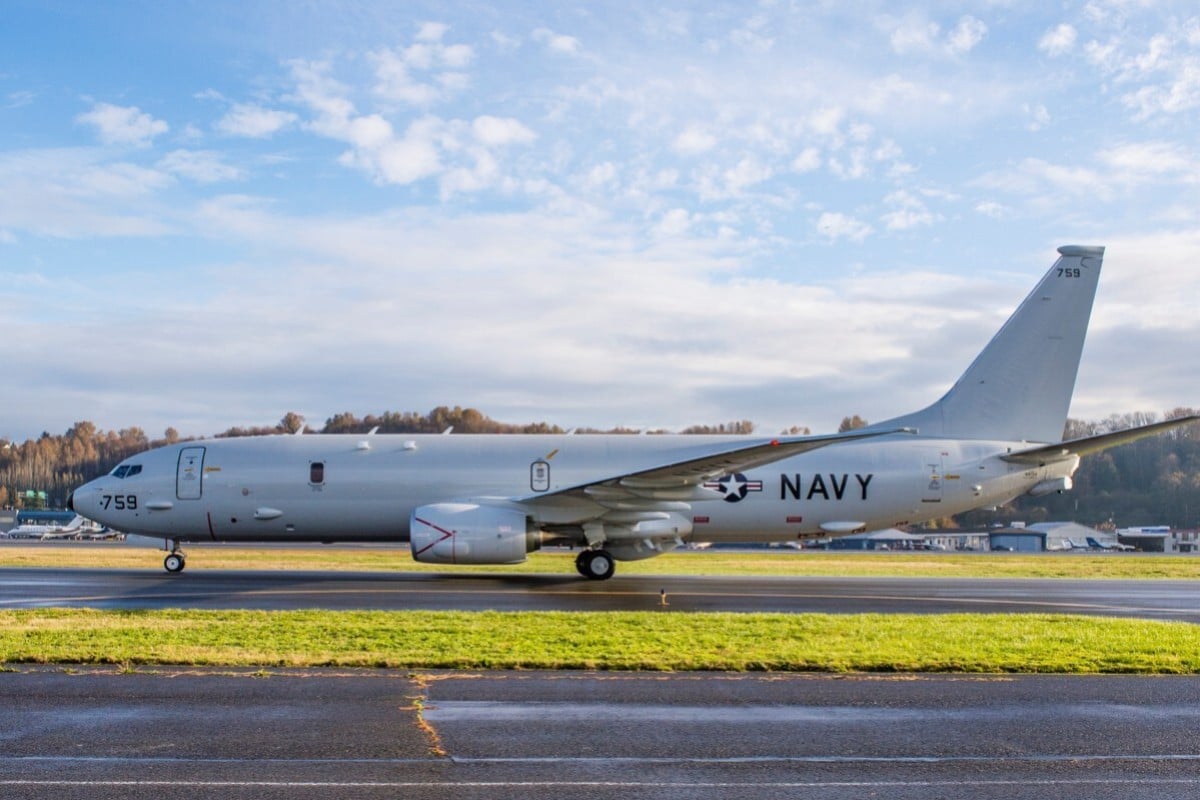Lawrence Chung
A Chinese think tank says a P-8A aircraft was among the planes sent out by the US Air Force to track Chinese submarines on Friday. Photo: US Navy/Boeing Aircraft/AFP
The US Air Force sent military planes to the Bashi Channel en route to the South China Sea for a sixth day in a row on Friday in what observers said was a mission to track mainland Chinese submarines.
The South China Sea Strategic Situation Probing Initiative, a mainland Chinese think tank under Peking University, said three American warplanes – a EP-3 reconnaissance plane, a P-8A anti-submarine aircraft and a KC-135 aerial refuelling aircraft – appeared in the Bashi Channel between 10am and noon.
In charts posted online, the think tank said the three planes flew briefly into the southwestern part of Taiwan’s air defence identification zone towards the Bashi Channel and then headed to the
“US EP-3E (AE1D91) is reconnoitring in the #SouthChinaSea, June 26. A P-8A and a KC-135 are following up, June 26,” the think tank said in a tweet.

US says China behaving aggressively in South China Sea amid coronavirus ‘disinformation campaign’
US says China behaving aggressively in South China Sea amid coronavirus ‘disinformation campaign’ Taiwan’s defence ministry declined to comment on the US military movements, saying only that it was fully aware of foreign military activities around Taiwan and that the armed forces were doing their job to ensure the security of the island and the safety of the Taiwanese public.
But it said a People’s Liberation Army warplane briefly approached southwest of Taiwan’s ADIZ in early on Friday afternoon and was warned off by Taiwan’s air force, which scrambled jets to shadow the aircraft.
The ministry did not identify the type of the plane.
The PLA aircraft apparently flew into the area shortly after the US warplanes, the ninth such incursion by a mainland aircraft since a US transport plane flew through the southwest coast of the island towards Thailand on June 9.
A Taiwanese security source who spoke on condition of anonymity said the US Air Force was apparently carrying out joint missions related to anti-submarine tasks.
“US warplanes have been massively reconnoitring between the Bashi Channel and the South China Sea, indicating that the USAF must have intelligence about PLA Navy submarine movements in the region,” the source said.

More footage emerges from 2018 near collision of US and China warships in South China Sea
More footage emerges from 2018 near collision of US and China warships in South China Sea
“With the involvement of a number of different kinds of warplanes, it also shows that the USAF is testing the readiness and reliability of its joint missions in this region.”
Su Tzu-yun, a research fellow at the Institute for National Defence and Security Research, said the American forces might have been acting on specific information.
“The US warplanes may have intelligence about the PLAN submarines and that could be the reason why the US warplanes were tasked to look for any unusual activities of the PLAN submarines in the Bashi Channel,” Su said.
He said that mainland ballistic missile submarines could attack the United States from the Philippine Sea to the east of Taiwan, and other waters in the region such as the Miyako Strait and the Bashi Channel could become the focus of more military movements
Mainland Chinese submarines appear to have been operating near Japan.
Last weekend, Japan’s defence ministry said it spotted a foreign submarine, believed to be a mainland Chinese vessel, underwater in a contiguous zone northeast of Amami Oshima Island, in Kagoshima prefecture.

Philippine officials unveil beaching ramp on disputed South China Sea island
Philippine officials unveil beaching ramp on disputed South China Sea island
Foreign submarines are required to surface and raise their national flags within territorial waters of other countries in accordance with international law. But underwater activities are not prohibited in contiguous zones, which surround territorial waters.
Japan sent Maritime Self-Defence Force destroyers and patrol aircraft to monitor the submarine, which passed through a narrow strip of water between the prefecture’s Tokara island chain and Amami Oshima without surfacing.
Japanese media quoted an unidentified SDF source as saying that the submarine might have been testing Japanese and US anti-submarine warfare capabilities.
Japanese Defence Minister Taro Kono said Japanese SDF aircraft also had to scramble daily in response to PLA warplanes approaching Japanese airspace.
“In the East China Sea, our fighter jets scramble against Chinese planes almost every day, sometimes more than once,” Kono said on Thursday, adding Beijing had opened a wide gap between the military arsenals of the two countries, building a great number of submarines, frigates and destroyers.
“We need to assess China’s capability and intention.”

Are Xi Jinping’s China and Donald Trump’s US destined for armed conflict?
He said Beijing had gone from a nation without modern fighter jets, submarines or frigates in the early 1990s to one with more than 1,000 fourth- and fifth-generation fighters, compared with the 300 or so fighter jets that Japan had.
Meanwhile, the US-based Defence News said earlier this month that US Secretary of Defence Mark Esper was studying the possibility of building large robot submarines to increase underwater surveillance.
According to the report, a study spearheaded by Esper’s internal think tank, the Cost Assessment and Programme Evaluation office, recommended that the US Navy invest in as many as 50 extra-large unmanned underwater vehicles.

No comments:
Post a Comment